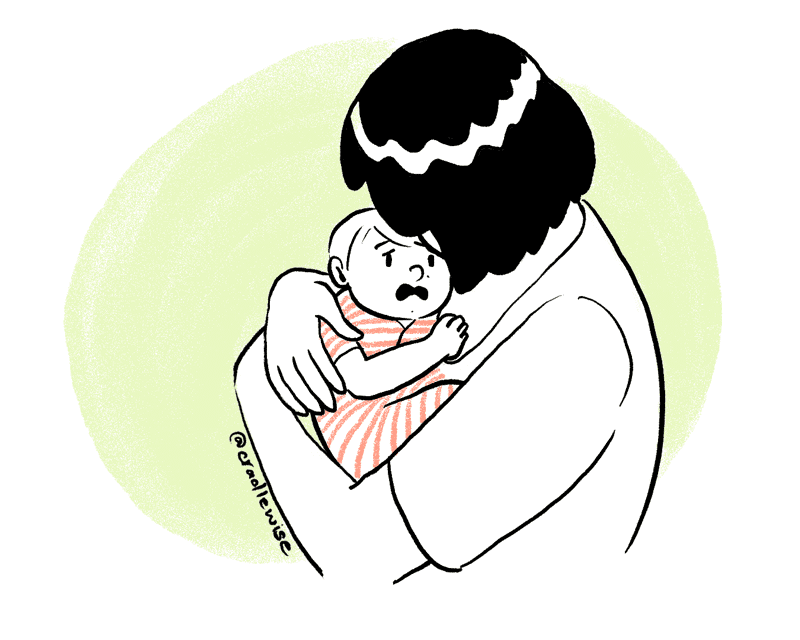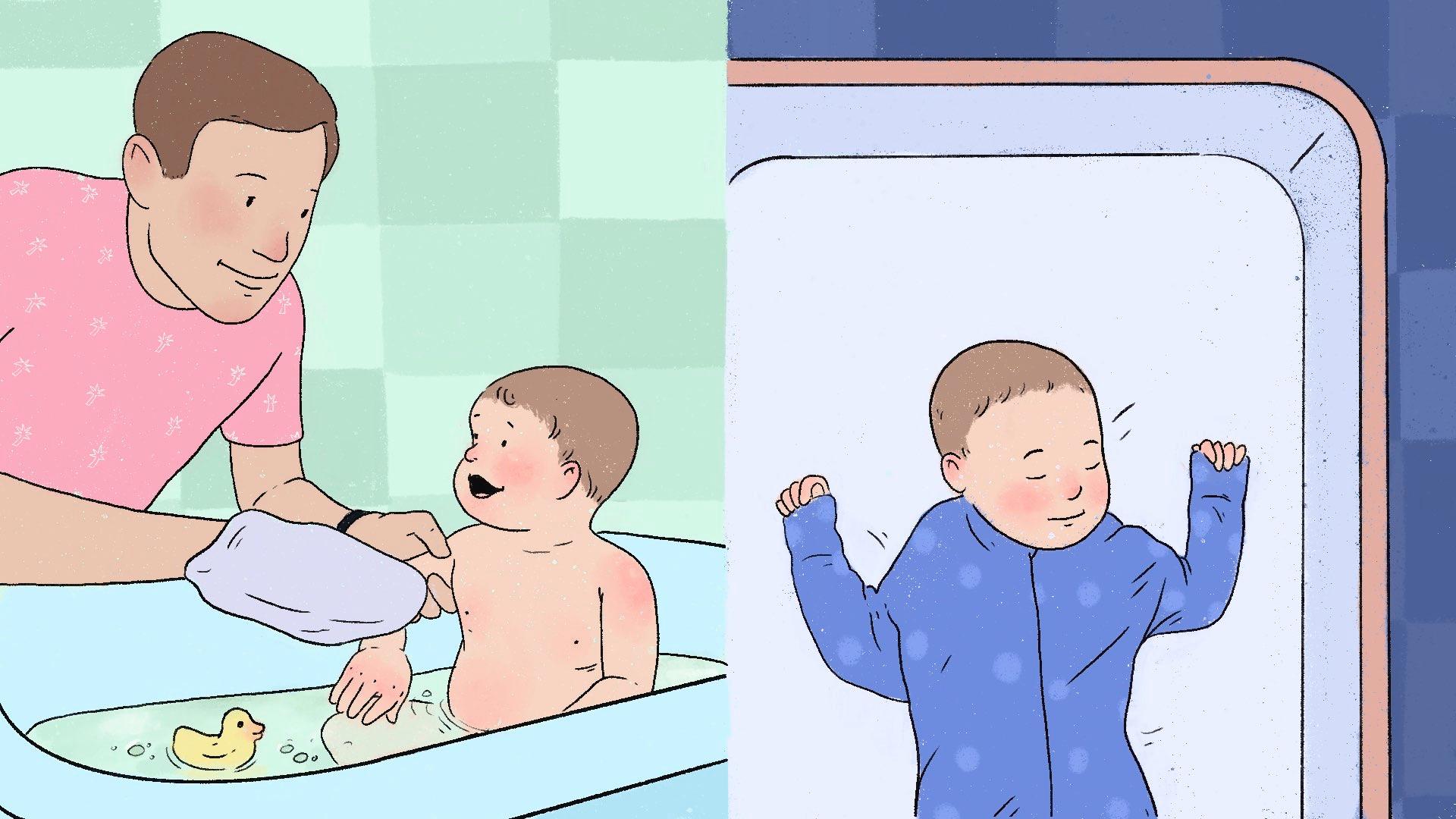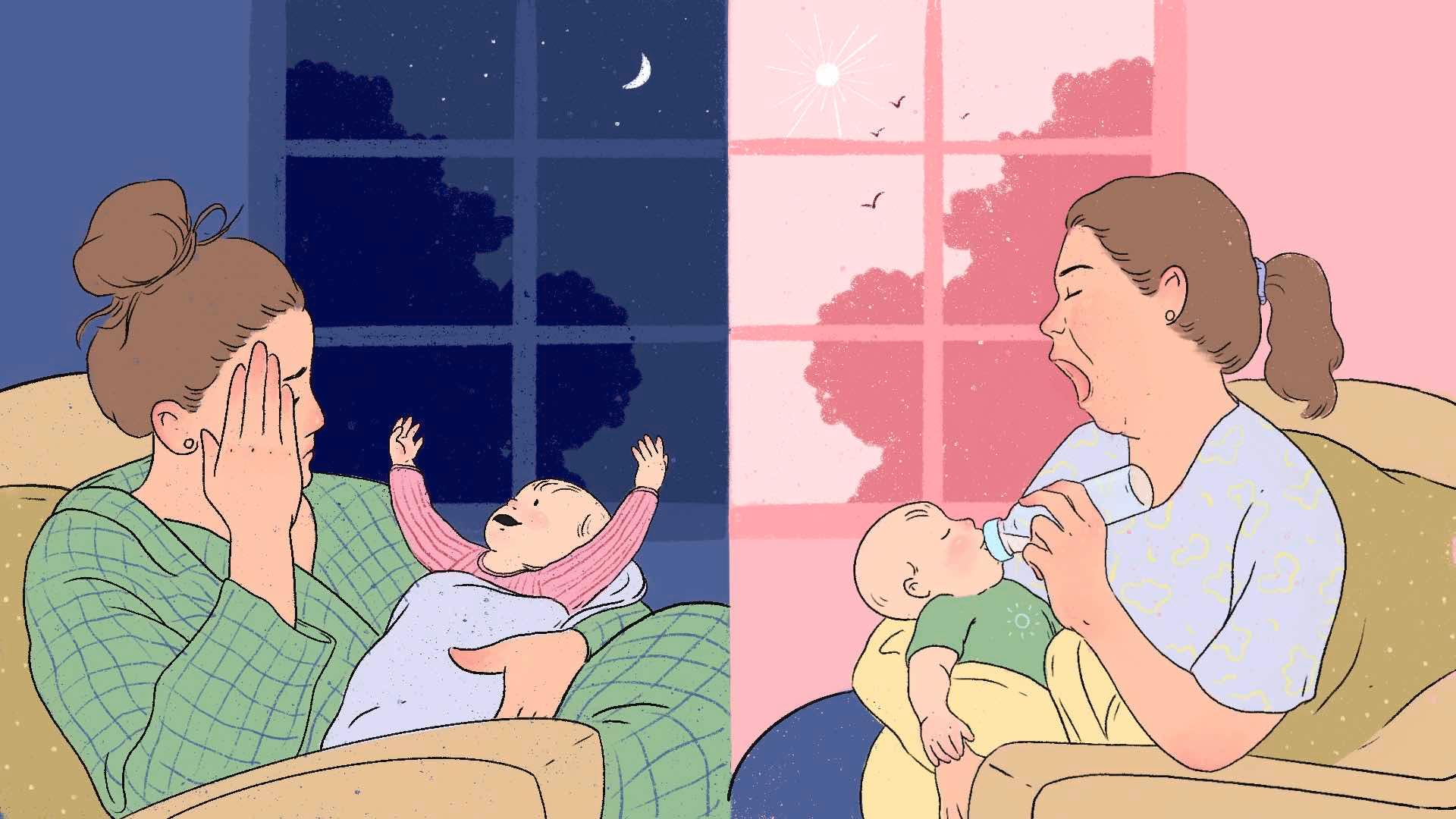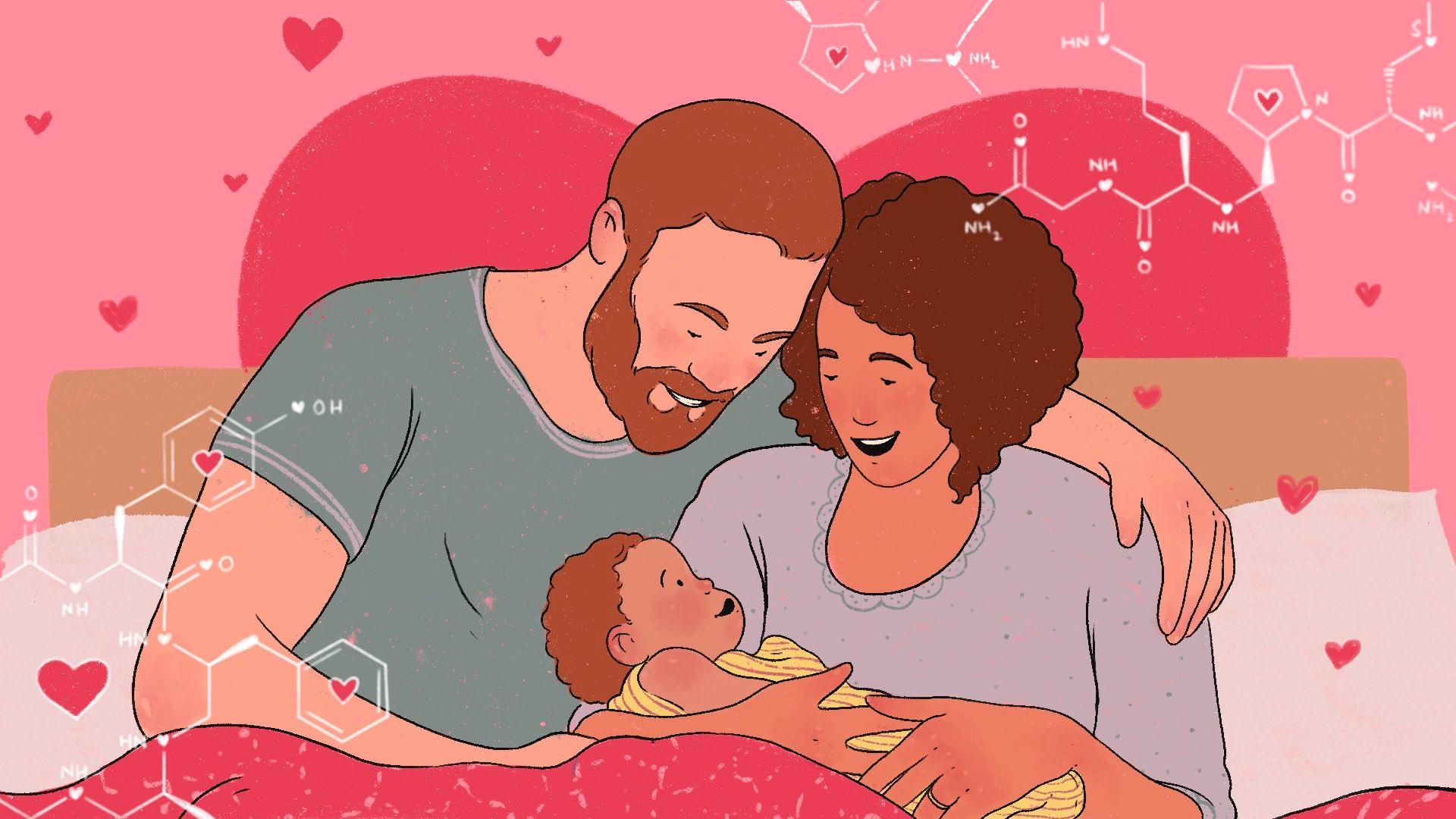Science of baby sleep
Sleep regression ages: Causes + signs + coping tips
Cradlewise Staff

Science of baby sleep
Sleep regression ages: Causes + signs + coping tips
Cradlewise Staff
Your baby has been sleeping longer stretches at night. They are hitting those nap time goals like a pro. But before you can get *too* excited, out of nowhere, your tot starts waking up every 30 to 40 minutes during the evening, refuses to nap at all, and when they do, they wake up shortly after you put them down.
How did this vicious cycle happen? You have no idea, but all you know is that you’re right back at square one of feeling like a zombie.
The likely culprit? Your baby or toddler is going through an infant sleep regression. As a parent, these changes can be super debilitating and lead to a string of sleep-deprived nights (and days).
But there is a silver lining—these “regressions” (we prefer to think of them as progressions) are a positive and healthy sign that your baby’s growth and brain development are on track! Baby sleep regression alone reveals secrets of how your baby is growing.
Read on for science-backed information on infant sleep regressions causes and signs, as well as expert-approved strategies on how to manage them.
What is sleep regression?
It’s a period when your baby who was sleeping through the night and napping well all of a sudden starts having problems getting adequate Zzzs—from waking up and frequently fussing during the night to resisting naps.
What causes sleep regression in babies?
As babies start growing and developing, many things can cause infant sleep regressions, including:
- Developmental milestones (Yay!). Your baby is learning to crawl and walk. They are learning new words and language(s).
- Growth spurts.
- Separation anxiety.
- Teething.
- Changes in their routine. Like their nap schedule, transitioning from a crib to bed, starting daycare, etc.
However, sometimes it’s easy to get confused and wonder whether your baby is going through a sleep regression or, say, just a growth spurt or a phase since both variables can impact sleep in similar ways.
Is it sleep regression or growth spurt?
According to Dr. Rebekah Diamond (MD), author of the upcoming book Parent Like A Pediatrician, “There isn’t a real meaningful difference between sleep regression and a growth spurt—it’s all a description to the challenging changes in a baby’s sleep behavior that happen during these periods of intensive development and growth.”
Changes in routine can cause behavioral infant sleep regressions, especially in older infants and toddlers. For example, dropping to one nap as they grow older, starting preschool, their day filling up with more activities, etc.
What are the signs of sleep regression?
Luckily, baby sleep regressions have some tell-tale signs.
Most of the time, when your little one is going through an infant sleep regression, they will have increased night wakings—the number of which depends on their age and the other factors—and/or find it hard to fall asleep at their usual bedtime.
A couple of days ago, they were falling asleep right on cue, and now they are fighting their bedtime routine. Same with their naps—they are skipping them or waking up earlier than they used to.
You will notice that your tot has become fussier all of a sudden—they are thrashing around in their crib, waking up even when they were recently fed and aren’t hungry, and their diaper isn’t wet!
Our smart crib’s soothing bounce feature can help ease this phase for you. With the help of machine learning, our crib gets smarter with time. It learns your baby’s sleep patterns and adjusts the bounce accordingly to soothe them.

How long do sleep regressions last?
Baby sleep regressions usually last between 2 to 4 weeks. However, each baby is unique. So the exact duration may vary depending on the cause and which milestone your LO achieved.
Baby sleep regression ages
Baby sleep regressions can occur at any age because of several factors ranging from a change in your baby’s environment to an illness.
Also, your infant or toddler is most likely not going to experience every single one of these regressions based on age. That’s some relief, right?
However, research states some common periods during which your child might regress:
4-month sleep regression
This sleep regression is often the hardest for parents because the changes it makes to your baby’s sleep cycle are permanent.
The 4-month sleep regression marks the beginning of the more mature sleeping patterns of your baby. They start developing adult-like sleep stages—first falling into light sleep, and then into deeper sleep stages. At this age, they are more easily roused when they are in the light stages.
Did you know?
Anything that makes your baby uncomfortable—a cough, cold, teething, or other illness—can cause a temporary sleep regression as well.

Did you know?
Anything that makes your baby uncomfortable—a cough, cold, teething, or other illness—can cause a temporary sleep regression as well.
4-month sleep regression signs
Dr. Diamond says, “The 4-month sleep regression is thought to be related to your baby being so excited to practice their new developmental skills. This includes increasing awareness of their surroundings that make them want to stay up and explore the world. Babies also start rolling over much more at this age and practicing this and other motor milestones can keep them awake.”
Since your babe is becoming more mobile and curious about their surroundings, swaddling becomes unsafe. Instead, you can try sleep sacks or wearable blankets for your baby’s safety.
When does the 4-month sleep regression end?
The 4-month sleep regression ends after 2 to 6 weeks. However, this may vary from baby to baby as all babies are unique.
8-10 month sleep regression
Your little one’s brain is growing rapidly at this age. They are mastering how to crawl, sit and pull up, learning the meaning of new words, and how to speak them, all around this time. They might also start feeling separation anxiety around this time due to independent bodily autonomy—all of which can lead to changes in their sleep cycle.
This happens because, at around eight months, your tot starts developing a new sense of object permanence—that even though mommy or daddy, or their favorite toys are out of sight, they are not gone forever. Their toys might be hidden somewhere, and mommy and daddy will come back. But babies don’t know when they will appear again, as they don’t have a sense of time.
So when you leave the room, your baby knows that you’re still around but not when you will be in their sight again. They get anxious and want you around them right now. This often leads to separation anxiety.
18-month sleep regression
Your toddler is experiencing a new concept of self and independence at this age. Their social-emotional sense, cognitive and physical strength are rapidly expanding. They will also get a full set of 12 baby teeth around this age. They are also more likely to feel separation anxiety.
Did you know?
For a lot of babies, separation anxiety can start around eight months. It usually peaks around 14-18 months and usually ends by the time a child is three years old.

Did you know?
For a lot of babies, separation anxiety can start around eight months. It usually peaks around 14-18 months and usually ends by the time a child is three years old.
2-year sleep regression
By their second birthday, your toddler looks at the world and their relationships with much more complexity. Around this time, they experience profound changes like dropping to one nap a day, moving to their own bed, potty training, etc. Some toddlers may experience night terrors, nightmares, and separation anxiety, along with other sleep problems.
Is it 6-month sleep regression or growth spurt?
Dr. Molly O’Shea (MD), the Founder of Birmingham Pediatrics, says, “Infants are growing all the time. Some do grow in spurts while others grow more consistently. Sleep regression has more to do with developmental leaps than physical growth. As a result, it will come at times of big change: learning to roll, learning to eat, learning to walk or talk, etc.”
How to handle sleep regression?
Baby sleep regressions will come and go along with your baby’s developmental milestones, growth, change in environment, and routine. Take a deep breath, and remember that it’s temporary.
Here are some other tips for managing baby sleep regressions that might come in handy:
1. Set routines
Dr. O’Shea (MD), says, “Routines are key. Eating at predictable times, having routines around sleep times during the day and at night is important. Avoiding electronics and screens for at least an hour before sleep (not even in the background) is important too.”
2. Recognize your baby’s sleep cues
Yawning, fussing, rubbing their eyes—try to get your baby to bed as soon as they start showing signs of sleepiness. Don’t wait till they get overtired and have a five-alarm meltdown.
3. Establish healthy sleep habits right off the bat
This could include giving your babe a warm bubble bath before bed, playing their soothing white noise tracks, reading them their favorite lift-the-flaps book, etc. Having a bedtime routine will help your baby associate these things with falling asleep when undergoing baby sleep regressions. Your Cradlewise can be used from day one as a bassinet and easily converts to a crib, making the transition easier for your little one, since they will be accustomed to the environment already.
4. Fully feed your little one during the day and before bed
This will ensure that they don’t wake up in the middle of the night because of hunger. Make sure that there are no distractions around when you’re feeding them. They are growing and curious about every little thing. Something on the TV, someone around them—and they might shift their attention before they are full. Feed them in a quiet, dimly lit room.
5. Make sure your tot has enough sleep during the day
If they don’t get enough sleep during the day, they will be overtired at night and have trouble falling and staying asleep.
6. Balance consistency and flexibility in their routine
Your baby is experiencing so many changes as their body and brain develop rapidly. Some semblance of their old routine might be comforting amongst all the new changes.
That said, remember that these changes in your baby’s sleep cycle are not permanent. Sometimes, you’re just going to have to adapt and improvise. Trust your parental spidey senses.
For example, if you feel like your tot needs to nap a little longer on a particular day, let them sleep even if it’s not a part of their schedule.
7. Ask for help
As hard as these sleep regressions are for your baby, they also take a toll on you as well. Take shifts with your partner. Call your besties or cousins or your mom. Ask them if they could spare a couple of hours and watch your little munchkin while you get some rest or spend some much-needed quality time with your partner.
8. Take care of yourself
In the middle of all this, remember to take care of yourself too. We know that our culture often glorifies mothers to sacrifice their needs and put everyone else first. But good parenting starts with giving ourselves grace. Don’t be apologetic for meeting your body and soul’s needs.
The bottom line
Baby sleep regressions are a sign of your sweetie’s healthy growth and development. We know the fussing and crying, staying up all night can be exhausting, however, sometimes your baby is going to cry despite your best efforts.
Dr. O’Shea weighs in on this, “Crying to fall asleep is sometimes a physical need to discharge energy to relax. Parents sometimes misinterpret that as a judgment against them or a cry for help when in fact it is a physiological need.”
So take it easy, you’re doing your best. This painful phase will eventually pass.
FAQs
Q: What are the signs of sleep regression?
A:Signs of infant sleep regression include: * Trouble falling asleep at bedtime * Fussing during naptime * Frequently waking during the night * Overall cranky behavior
Q: At what age does sleep regression occur?
A: Sleep regressions can occur at any age. However, sleep regressions most commonly occurr at age 4 months, 6 months, 8 months, 18 months, and 2 years.
Q: How do you end sleep regression?
A: There’s no hard and fast rule for you to end your baby’s sleep regression. Most of the time, regressions end on their own after two to four weeks. Follow a routine and learn to follow your LO’s sleep cues.
Q: What age do babies have sleep regression?
A: Sleep regression in babies typically occurs around 4 months of age, when they go through significant developmental changes that can disrupt their sleep patterns.
Q: What triggers a sleep regression?
A: Sleep regressions can be triggered by various factors, including growth spurts, teething, changes in routine, and cognitive development milestones such as learning to crawl or walk.
Sources:
- Baby sleep regression ages. Wiley Online Library. 2016. “Development of infant and toddler sleep patterns: real-world data from a mobile application.”
- Brain development and growth during sleep regressions. Europe PMC. 2011. “Sleep and Infant Learning.”
You may also like



